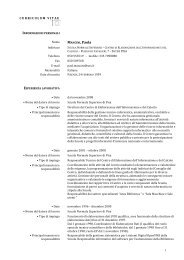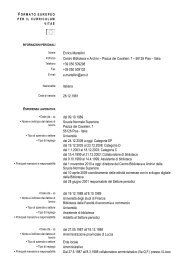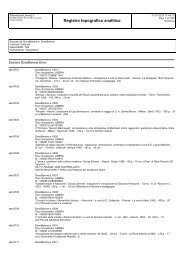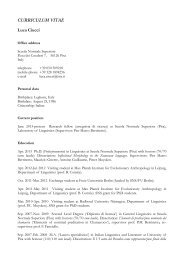Metrics of curves in shape optimization and analysis - Andrea Carlo ...
Metrics of curves in shape optimization and analysis - Andrea Carlo ...
Metrics of curves in shape optimization and analysis - Andrea Carlo ...
Create successful ePaper yourself
Turn your PDF publications into a flip-book with our unique Google optimized e-Paper software.
The pro<strong>of</strong> is by direct computation.For example, from (4.5) we easily obta<strong>in</strong> (2.7), that is∫D c,h avg c (c) = h + (c − avg c (c))(D s h · D s c) ds .cIf C(t, θ) is a homotopy, we can obta<strong>in</strong> a different <strong>in</strong>terpretation <strong>of</strong> all previousequalities substitut<strong>in</strong>g formally C for O, ∂ t for D c,h <strong>and</strong> eventually ∂ t C for h.The above proposition helps <strong>in</strong> formaliz<strong>in</strong>g <strong>and</strong> speed<strong>in</strong>g up calculus ongeometric quantities, as <strong>in</strong> this example.Example 4.6 We can Gâteaux-derive the “second arc parameter derivativeoperator D ss ” by repeated applications <strong>of</strong> (4.3), as followsD c,h (D ss g) = −(D s h · D s c)D ss g + D s [D c,h (D s g)] == −(D s h · D s c)D ss g + D s [−(D s h · D s c)(D s g) + D s (D c,h g)] == D ss (D c,h g) − 2(D s h · D s c)D ss g − [D s (D s h · D s c)](D s g)<strong>and</strong> hence obta<strong>in</strong> the Gâteaux differential <strong>of</strong> the curvatureD c,h D ss c = D ss h − 2(D s h · D s c)D ss c − [D s (D s h · D s c)]D s c<strong>and</strong> eventually obta<strong>in</strong> the Gâteaux differential <strong>of</strong> the elastica energy bysubstitut<strong>in</strong>g this last equality <strong>in</strong> (4.4)∫∫D c,h |D ss c| 2 ds = 2D ss c · (D c,h D ss c) + |D ss c| 2 . (D s h · D s c) ds =cc∫= 2D ss c · D ss h − 3(D s h · D s c)|D ss c| 2 dss<strong>in</strong>ce (D ss c · D s c) = 0.cRemark 4.7 Most objects we deal with share an important property: they arereparameterization <strong>in</strong>variant. In the case <strong>of</strong> operators, <strong>in</strong> all cases <strong>in</strong> whichO(c) is a curve or a vector field, then this means that for any diffeomorphismϕ ∈ Diff + (S 1 ) there holdsO(c ◦ φ)(θ) = O(c)(φ(θ)) . (4.6)(whereas for ϕ ∈ Diff − (S 1 ) there is a possible sign choice as expla<strong>in</strong>ed <strong>in</strong> Def<strong>in</strong>ition1.5).By consider<strong>in</strong>g an <strong>in</strong>f<strong>in</strong>itesimal perturbation a : S 1 → lR <strong>of</strong> the identity <strong>in</strong>Diff(S 1 ), we obta<strong>in</strong> the formulaD c,h O(c)(θ) = a(θ) . ∂ θ O(c)(θ) for any h(θ) = a(θ).∂ θ c(θ) (4.7)<strong>and</strong> this last may be rewritten <strong>in</strong> arc parameterD c,h O(c)(s) = a(s) . D s O(c)(s) for any h(s) = a(s).D s c(s) . (4.8)Similarly if E : M → lR is a reparameterization <strong>in</strong>variant energy, thenD c,h E(c) = 0 for any h = a.D s c . (4.9)36




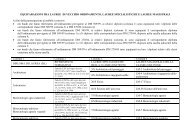
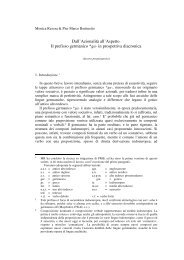
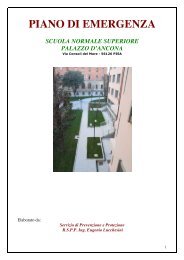
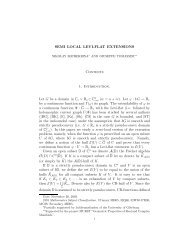
![4. Ghost [Å] vowels in French - Laboratorio di Linguistica](https://img.yumpu.com/49999334/1/184x260/4-ghost-a-vowels-in-french-laboratorio-di-linguistica.jpg?quality=85)



